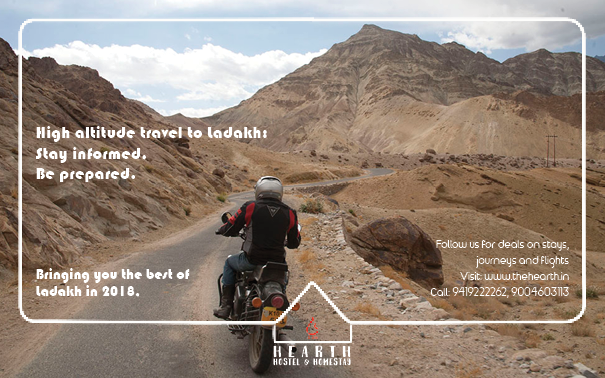HIGH ALTITUDE TRAVEL TO LADAKH
Ladakh also known as the land of endless discoveries stands 11000ft high in the Indian Himalayas. Awe inspiring landscape and serene waterbodies have appealed travellers to the region since it first opened to international tourist in 1984. Environmentalist have written extensively on the fragile high altitude eco system pertaining the ever expanding tourist industry.
As beautiful the high altitude region of Ladakh is, the challenges of traveling to Ladakh can be felt with the first breath on your arrival. A major concern of travellers visiting Ladakh is combating the rise in altitude and the many effects it has on our physiology. Acute mountain sickness (AMS) typically occurs at about 8,000 feet, or 2,400 meters, above sea level with early symptoms of dizziness, nausea, headaches, and shortness of breath. However, mountain adventure enthusiasts and travellers can take measures to train the body to acclimatise to the altitude.
The human body is an epitome of adaptation and so it can take the altitude of Ladakh if we can pace the elevation rightly and restrict ourselves to limited bodily exertion and stress. Acclimatising for the body for high altitude travel starts a week before your trip with easy walks in the mornings to flex your muscles and the right cardio routine.
Acetazolamide or Diamox: Anti altitude prevention medication
Anti altitude sickness pills or Acetazolamide can help and should be taken a day before your flight to Leh or your ride from Manali to Serchu. This pill cane be taken at an interval of 6 hours (prescription of medical expert advised). Diamox is a popular Acetazolamide that helps in preventing acute mountain sickness (AMS), high altitude pulmonary edema (HAPE), and high altitude cerebral edema (HACE). However you should consult professional medical expert before taking any prevention pills.
Rest is best
On arrival in Leh it is very important to avid physical exertion and any stressful routine. A complete rest for the first two days with good sleep cycles and staying indoors for the first couple of days will allow your body the time it needs to adapt to the thin air, scarcity of oxygen and dryness. Moderating your routine from mild to heavy workouts or walks will allow the cardio muscular movements to adapt to the oxygen inflow.
Proper diet and hydration
A good diet plan with optimum intake of carbohydrates can help the body get energy and at the same time avoiding oily, fat rich food stressing our digestive system is advised. One of the major physiological shifts our body goes through as we enter Ladakh is dehydration. Travellers tend to loose a lot of fluids in Ladakh and due to less perception they hardly feel thirsty. Travellers should keep sipping on water, soups and other fluids and keep the body adequately hydrated.
Leave the beer
As we have already discussed how hydration plays an important role in combating mountain sickness, it goes without saying that alcohol is to be avoided strictly as it dehydration rates the body and can destroy your entire travel experience. You should cut down your consumption to a quarter of what you usually take only on the third day onwards. It is advised that for the first two days you should strictly stay away from any alcoholic drinks and bars.
Prevention for skin
Apart from the thin air, being close to the sun is another change effecting our immediate health when we are traveling to Ladakh. Travellers don’t realise the impact of exposure to Sun as the atmosphere does is not protecting them from harmful rays. There is a 10 present increase in exposure to rays at every 1000 feet. So a traveler coming to Ladakh from Mumbai or Ahmedabad will experience an increase 100 percent increase in Sun’s rays effecting our skin. We suggest cold pressed apricot oil, moisturisers, good brand Sun screens with SPA 150 and above for all skin types to avoid burns or dryness. Also at this hight sunlight can be erring to the eyes, so don’t forget to carry a good pair of polarised, UV protected glares and hats to cover your head and eyers.
Dust
Barren landscape of Ladakh makes it a dusty terrain and you never know when you will find yourself in the middle of a dusty breeze. Also contributing to this problem is the heavy infrastructure development Leh is going through. The roads are dug up, hotels and other tourism construction projects are coming up at every corner. We advise travellers to carry a pair of scarf, strolls and face masks to escape from tiny dust particles from entering your nasal cavity. Also keeping the nose and ears moist helps in optimising hydration of these parts.
A journey can be explored better, if we read and prepare about the destination before landing there. So keeping in mind the above measures will help you to acclimatise and enjoy the natural splendour of the trans Himalayan region of Ladakh. Drink a lot of water, sleep well and avoid alcohol and you will be fine to explore the beautiful mountain terrain and you will come back for ever more.
P.C: Stanzin Khakyab
Tags: All Travel High-Altitude-Sickness Care Prerequisites Travelling-Ladakh-2018 Leh-Ladakh




